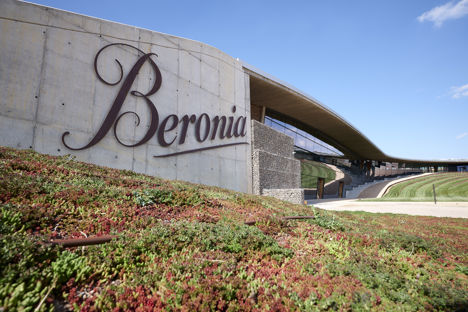
Rioja with a conscience: Spain’s super-sustainable winery
Situated in the heart of La Rioja Alta, Beronia’s Ollauri winery is one of the most sustainable in Europe. We uncover how the design of the winery and the innovative technology used there help Beronia push the boundaries of eco-friendly wine making.
Rioja with a conscience: Spain’s super-sustainable winery
Situated in the heart of La Rioja Alta, Beronia’s Ollauri winery is one of the most sustainable in Europe. We uncover how the design of the winery and the innovative technology used there help Beronia push the boundaries of eco-friendly wine making.
As the world’s population becomes increasingly aware of the necessity to move towards a far more sustainable way of living, businesses and industries are also beginning to change the way they function to reduce their impact on the planet. Some, however, are ahead of the game. With so many different moving parts and factors to take into account, wineries have an even tougher job than most to function in the most energy-efficient way possible, whilst ensuring the taste and quality of the wine is as good as ever. But that hasn’t phased winemakers Beronia, who in 2018 began building one of the most sustainable wineries in Europe to set a new global benchmark in wine production. In 2021, it opened to the public.
Nestled away in the hills of Spain's La Rioja Alta, Beronia’s Ollauri winery uses a combination of carefully thought-out architecture, renewable energy sources and cutting-edge technology to reduce its impact on the environment, in line with the company’s commitment to sustainability. The idea behind the winery is to create a holistic approach to winemaking, resulting in a sustainable product which faithfully embodies the terroir of the region. It’s this ethos which has helped it become the first winery in Europe to achieve LEED (Leader in Energy Efficient and Sustainable Design) status, as well as a Wineries for Climate Protection certification.
Designed in such a way that it blends into the surroundings, the Ollauri winery is covered with a canopy that’s home to an array of plants and herbs along with thermal solar panels which supply renewable energy to the rest of the building. An impressive angled glass front ensures that the space is flooded with natural light during the day, reducing the amount of energy used, while the structure is also designed to collect rainwater which can be used when non-drinking-water is required. A feat of architecture from the outside, most of the winery is actually hidden beneath the ground for two reasons: to save energy through the use of gravity when transporting the grapes and wine from level to level, and to provide the ideal conditions for ageing the wines. Even noise pollution has been carefully thought about, with the hall containing the bottling line (which accounts for a lot of clinking) surrounded by prefabricated concrete walls.
It would be impossible to make wine without the use of barrels, but most wineries end up using a lot of energy disinfecting and regenerating them, and then still often end up disposing of the barrels after just a few years. However, Beronia is the first winery in the world to use 'Cleanwood' technology to treat its barrels. This innovative system uses high-frequency waves to regenerate barrels in just four minutes, eradicating any microorganisms living in the wood as it does so. Not only does this lead to higher quality barrels which ultimately last longer and produce better tasting wine; it also uses far less energy and water that traditional barrel cleaning systems, once again showcasing Beronia’s commitment to taking the more sustainable option whenever possible.
However, what really makes the winery stand out from others in Europe is its use of structural thermo-activation to create geothermal energy and in turn heat or cool the water flowing around the building, depending on the time of year. Buried 130 metres underground, the pipes carrying the water make use of concrete’s thermal inertia and the constant temperature of the earth at that depth to dramatically reduce the use of unnecessary energy. This is further complemented by a state-of-the-art sustainable air conditioning system which can mimic the conditions of a cellar deep underground by adjusting the temperature, again via the use of geothermal energy. In short, this is seriously cutting-edge science in action, all with the aim of creating delicious yet far more environmentally friendly wine.
Beronia has demonstrated that winemaking and sustainability can go hand in hand, which in turn has helped owner Gonzalez Byass become recognised as the best Spanish winery of the decade. Every element of the Ollauri winery has been carefully considered and designed to be as sustainable as possible, from its barrel cleaning system to the reduction of noise pollution and the treatment of waste products. Even so, the company is still constantly looking for things it can do even more efficiently. That's why Beronia is one of the names at the forefront of sustainable wine production in Europe.


